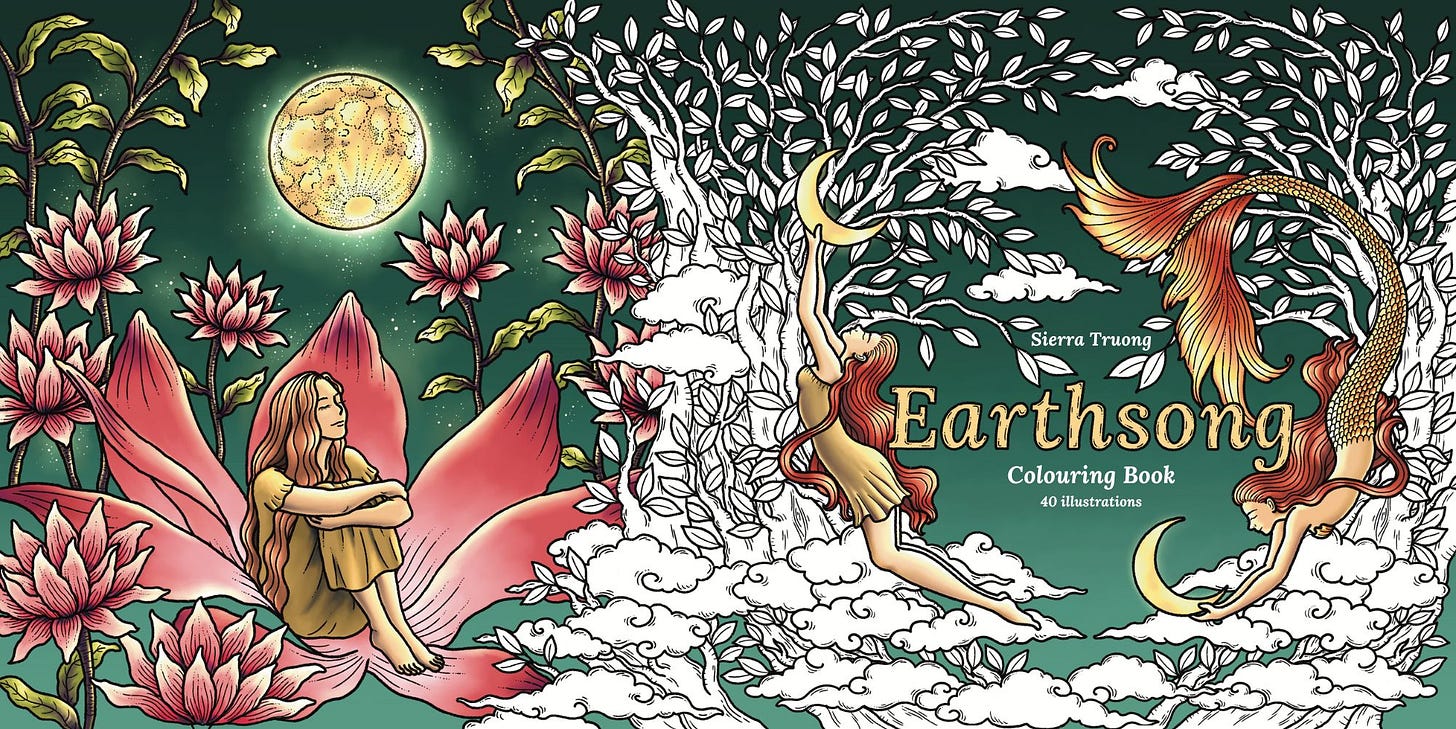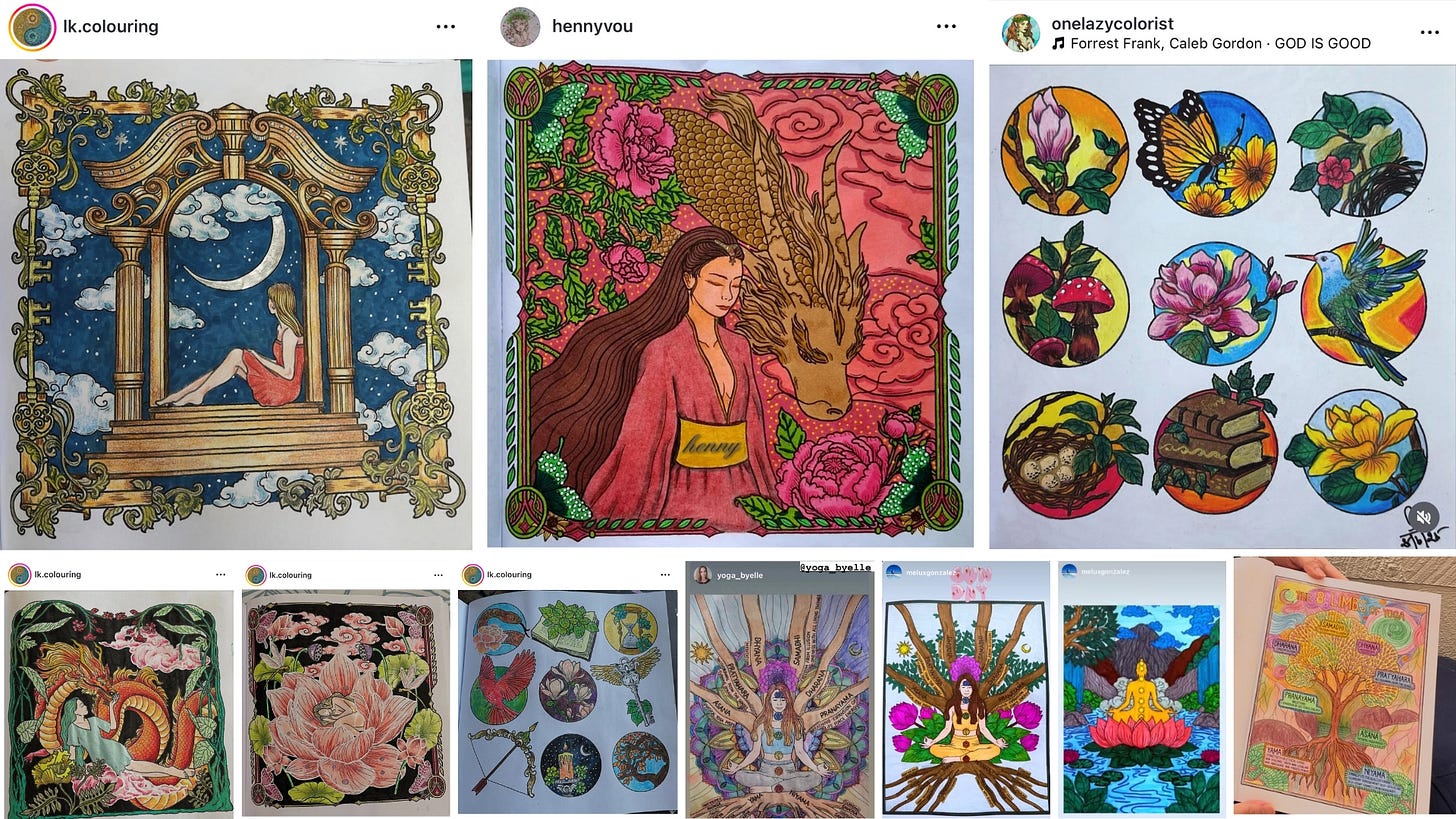Not Just for Kids: The Mental Health Magic of Adult Colouring

As a kid, I never liked colouring. I always thought it was the least creative and most boring art activity of … just filling in someone else’s lines. Many people would probably agree with me, especially those who never really tried it like myself back in those days.
Around 2013, Johanna Basford changed the game. Her colouring book Secret Garden opened the door to a whole new world of adult colouring. Since then, countless beautiful books have been published, and people of all ages have fallen in love with it.
Well! I still wasn’t convinced. I didn’t try colouring myself until 2019.
There was something about adult colouring that felt familiar to me, but I never connected the dots until later.
My background is in architecture, and as part of my degree, I had some fine art training with watercolours, oil painting, markers, and Indian ink for rendering architectural drawings.
Actually, hand-rendering was my favourite part of architecture school. And looking back now, I realize that rendering is very much like adult colouring. It’s not just about “filling in” the spaces. It’s about creating textures, shades, and shadows, bringing the page to life with depth and detail. That’s the real charm of adult colouring. (And let’s not underestimate kids either, many children can do this beautifully too!)
If anyone says colouring isn’t creative enough, it’s probably because they haven’t tried it, or haven’t seen how colourists can bring a page to life.
So that’s the technical, artistic side of it. But, today I want to talk a little more on the mental health magic of colouring.
As a meditation and mindfulness teacher, and as someone who used to experience anxiety on a daily basis, I’ve seen and experienced firsthand how colouring can be more than just an art form.
It is a gentle, meditative practice that calms the mind, soothe the nervous system and brings joy back into everyday life.
How the Simple Practice of Colouring Supports the Nervous System and Mindfulness
In an age of constant stimulation and stress, many people, including myself, are turning to simple, hands-on activities to find relief from anxiety and mental fatigue.
I’ve been a meditation practitioner since 2014, and although I meditate daily, I still experience anxiety which began when I started my business. A few years ago, I realized that meditation and mindfulness are only one wing; the other wing that helps lift my anxiety is creative practice, specifically colouring. That was when I make sure I put aside at least 30 minute everyday after work for colouring.
So what makes colouring so calming, and how exactly does it support the nervous system and mental well-being?
Before we dive into the science and research, just imagine this scene:
After a long day of work, you take a shower and slip into your comfortable clothes. You light a candle, play your favourite playlist (doesn’t need to be calming music - I play my gothic rock playlist! Super fun!), pour yourself some warm herbal tea or hot chocolate, and settle in for a session of colouring.
How does that feel to you already? Okay… now let’s explore what actually happens when we pick up a pen and start colouring.
Colouring and the Nervous System
Colouring engages the parasympathetic nervous system, the part of our body responsible for “rest and digest” functions. When this system is activated, the heart rate slows, breathing deepens, and stress hormones like cortisol begin to decrease. This creates the physiological opposite of the “fight or flight” response of the sympathetic nervous system triggered by stress and anxiety.
The simple, repetitive motion of colouring like shading, filling spaces, blending creates a rhythmic flow, which can be meditative. This repetition activates the parasympathetic nervous system, slowing the heart rate and promoting relaxation.
Other art forms, especially ones that involve performance or expression (e.g. sculpture, dance, or even spontaneous painting), may be more emotionally or physically activating than calming.
The next time you colour in, take a few moments to notice how you feel. See if your heart rate slows down, and observe whether you feel more relaxed.
A 2017 study published in Art Therapy: Journal of the American Art Therapy Association found that just 20 minutes of colouring a mandala significantly reduced anxiety levels in adults. The participants showed measurable improvements in mood and stress reduction, even after a single session.
Further neuroscience research shows that creative tasks like colouring engage the default mode network (DMN) in the brain. This is a system of interacting brain regions associated with self-reflection, daydreaming, and emotional regulation. When we're colouring, the brain shifts into a state of relaxed wakefulness that promotes internal calm and balance.
Colouring as a Mindfulness Practice
Colouring is also an accessible form of mindfulness, a mental state defined by non-judgmental awareness of the present moment.
Unlike painting or drawing from scratch, which can involve complex choices (composition, subject, proportions, technique), colouring in offers just enough structure. The outlines are already there, so your brain doesn't have to make high-level creative problem solving decisions. This reduces cognitive load, allowing you to relax more easily into the process.
Mindfulness is about non-judgment and presence, not performance. Colouring doesn't ask you to "come up with an idea" or "make something great." You're simply interacting with what's already there. This removes a little bit of the inner critic and makes space for quiet observation and enjoyment.
Not everyone feels confident in their artistic skills. Colouring, however, is widely accessible because you don’t need to be “good at art” to enjoy it or feel the benefits. That psychological safety helps people engage more fully and mindfully without fear of failure.
Colouring In Comparison with other art forms:
All art forms are great in their own way and serve different purposes.
But, what makes colouring more approachable and considered more relaxing is its structured yet open-ended nature, which makes it uniquely accessible for those who don’t see themselves as ‘artistic.’ With no pressure to perform or create something original, colouring allows the mind to slow down, the nervous system to relax, and the spirit to play.
-
Freestyle drawing or painting may trigger overthinking or self-criticism. Plus the pressure of starting on the blank page or blank canvas and the pressure of coming up with a structure yourself. It requires more will power to let go and surrender to the creative process than colouring.
-
Sculpting or mixed media might require more space, tools, or setup, which can interrupt mindfulness and involve extra cleanup and organisation.
-
Dance or performance art may be expressive, but not always grounding or quiet.
Why This Simple Practice Works
At a neurological level, colouring does something actually quite profound:
-
It activates the brain’s reward system, releasing dopamine as we complete shapes or choose colours we love.
-
It deactivates the amygdala, the brain’s fear centre, which becomes hyperactive during stress and trauma.
-
It builds sensory integration, especially in those recovering from trauma or managing conditions like PTSD or ADHD.
Getting Started
You don’t need much to start: a colouring book that inspires you (fantasy, mandalas, botanical designs, whatever speaks to you), a set of markers, or coloured pens, and a quiet space. Try to colour without judgment or pressure. Let your attention rest gently on the page.
Even 20 to 30 minutes can help reset your nervous system, regulate your emotions, and give your mind a much-needed break.
Recommended art tools:
These are the tools I've used and loved over the years. They're some of the leading art supplies in the colouring world.
-
Ohuhu alcohol markers: If you are in New Zealand, Moon Art NZ is the supplier of Ohuhu markers.
-
Prisma coloured pencils: If you are in New Zealand, you can find Prisma products at Gordon Harris.
-
Faber Castell Polychromos coloured pencils: If you are in New Zealand, they are available at Ribbon Rose and Gordon Harris.

How I use the tools:
-
Ohuhu markers on its own.
-
Ohuhu marker as a base layer & coloured pencils on top for depths and details. This is so far my most favourite way to colour my pages.
The colouring books that I published:
I began publishing my own colouring books in 2024 with many of my original illustrations from 2020. The first two books in the list below have been my bestsellers so far. You can find all of my books on my website or Amazon. Below is a list of my books:
-
Yoga Girls Colouring book: A beginner's guide to the 7 chakras & 8 limbs of yoga.
-
Earthsong
-
Sacred Presence: A colouring journey through love, joy and wonder.
-
Slow Living Colouring book: The Way of Tea.
-
Slow Living Colouring book: Every Day Magic.
-
Slow Living Colouring book: In Rhythm with Nature.
Our Mindfulness Colouring & Creative Connection Gathering in Auckland:
Another fun gathering I started hosting this year in Auckland is our colouring sessions, where we sit together, colour, chat, and sip tea. Colouring is a wonderful activity to enjoy either alone or in a group. Many colourists also enjoy something called ‘buddy colouring,’ where they buy the same book and colour the same page in their own books together. What a beautiful way to bond!





